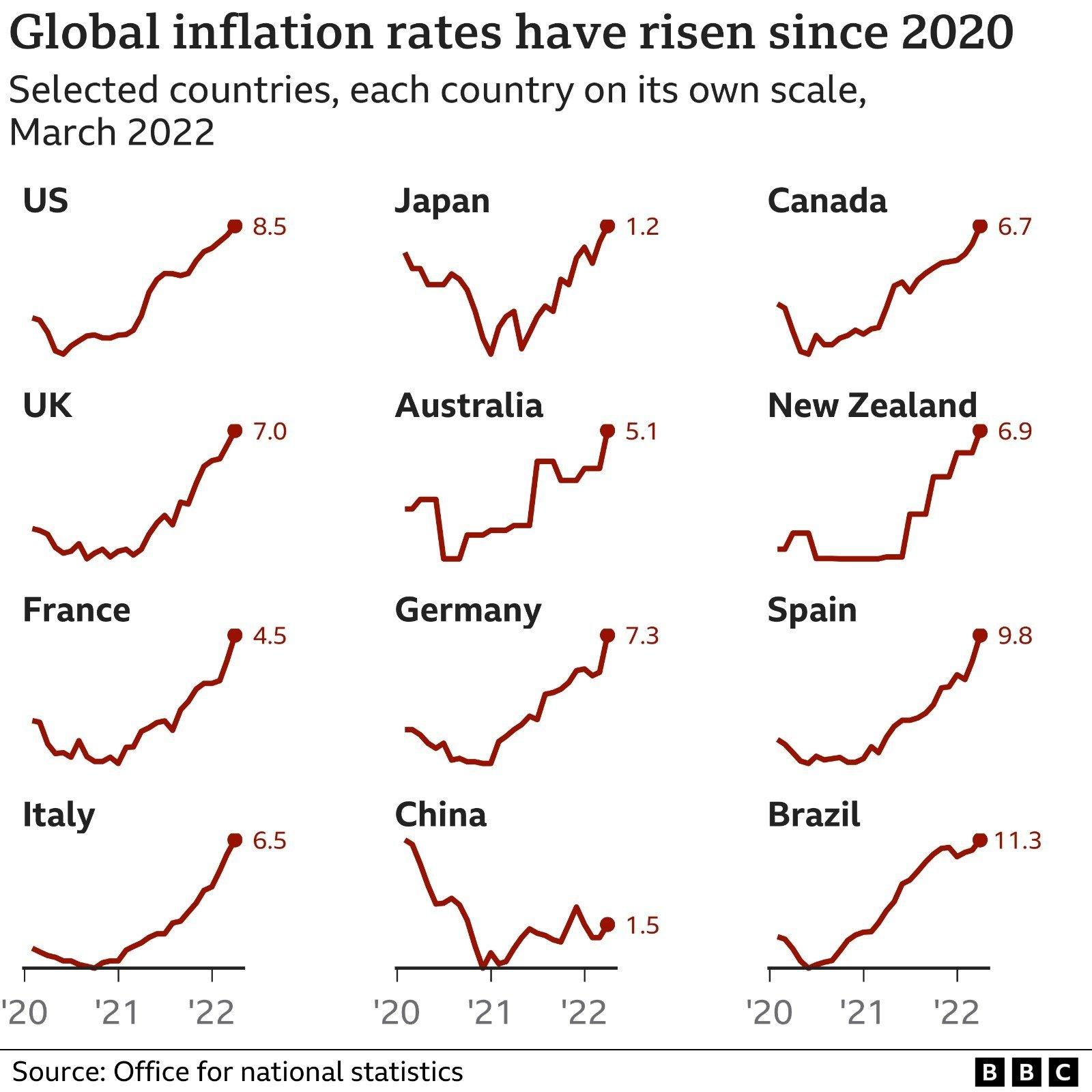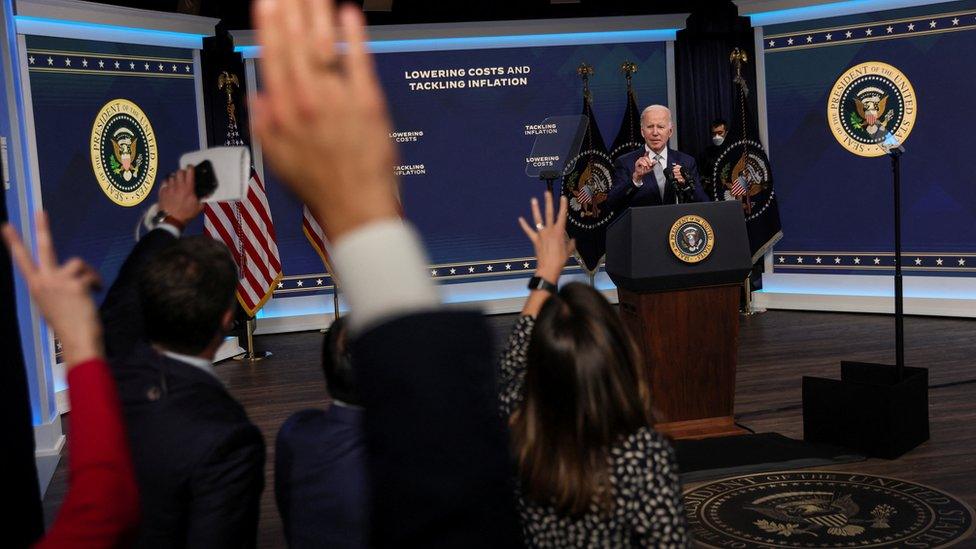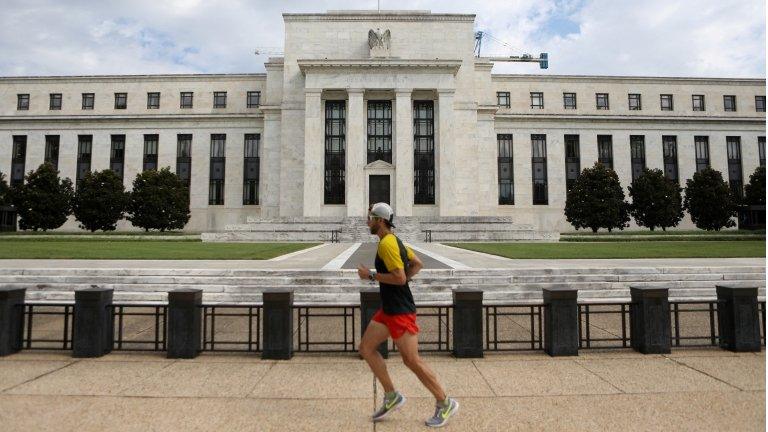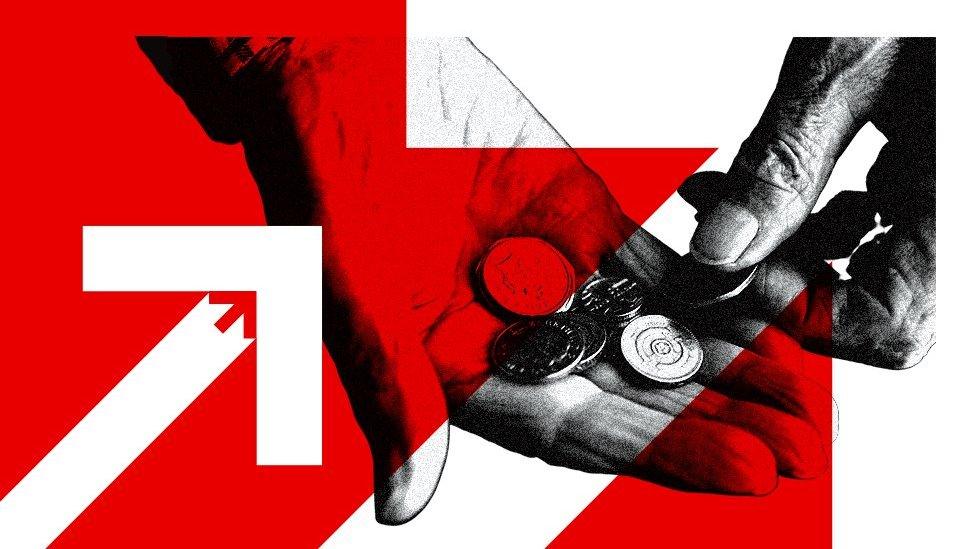Why is inflation in the US so high?
- Published

Last year, businesses around the world started raising prices at a pace not seen in decades. Among major economies, one country was hit the worst - the United States.
Prices jumped at an annual rate of 4.7% last year - faster than any other country in the Group of Seven (G7) advanced economies, according to the Organisation for Economic Cooperation and Development (OECD). In the UK, for example, inflation was just 2.5%.
Last month, inflation in the US hit 8.6%, one of the highest rates in the world.
Many of the forces driving inflation last year - such as supply disruptions from Covid and higher food prices after severe storms and drought hurt harvests - were not unique to the US.
The reason the US fared worse? In two words - high demand.
That was driven by the massive $5tn (£4.1tn) in spending the US government approved to shield households and businesses from the economic shock of the pandemic.
Government spending
By cushioning family finances, the aid - which included direct cheques to households - helped people keep buying.
Goods like furniture, cars and electronics saw a surge of orders, as shoppers redirected money they might otherwise have spent on restaurants and travel.
And as unusually high demand collided with supply issues stemming from Covid, businesses raised prices.

A recent study by the Federal Reserve Bank of San Francisco concluded that pandemic relief packages probably contributed to 3 percentage points of the rise in inflation until the end of 2021 - a factor that goes a long way to explaining why US inflation outpaced the rest of the world.
Oscar Jorda, senior policy adviser at the bank and one of the people who worked on the study, cautioned against reading too much into the exact percentages, but said the overall picture is clear.
"These programmes... were a considerable infusion of liquidity into consumers' pockets at a time when perhaps industry wasn't quite ready to respond to an increase in demand," he said in an interview in May. They "signified a big push of what I would call demand push inflation".
Slow Fed response
The risks that the packages would drive inflation were raised before they were passed, most notably by Harvard economist Larry Summers, a longtime Democratic policy adviser, as well as some Republicans.
But others, including the head of the Federal Reserve, America's central bank, argued that price increases would be "transitory" and fade as Covid-related supply chain issues abated.
The Fed - which launched its own stimulus policies at the start of the pandemic - was slow to respond to the price increases, even as inflation expectations in the US more broadly began to shift, says economist Ricardo Reis, a professor at the London School of Economics.
"That [shift in expectations] is what turned transitory into persistent and again the Fed was slow to respond to that."
Since US households were bolstered by the stimulus cheques, rising prices weren't widely felt as a cost of living crisis last year, despite wage gains lagging.
But as savings get spent, that is changing, creating a serious political problem for US President Joe Biden, whom Republicans blame for the price increases.

Joe Biden's approval has sunk as inflation concerns intensify
Mr Biden in turn has pointed the finger at the war in Ukraine, which has hit oil supplies and exports of commodities like wheat, driving up prices and spreading the pain around the world.
In the Euro area, prices climbed at an annual rate of 8.1% in May, led by countries that are close to Russia and relied on its oil and gas like Estonia, where prices were up 20.1%.
In the UK, also heavily reliant on food and energy imports, inflation hit 7.8% in April, just behind the US among advanced economies, after a price cap that had limited energy bills was raised, the OECD said.
Consumer price figures from the UK government, which exclude a measure of housing costs factored into the OECD figure, showed an even faster increase of 9%.
Even Japan - which has struggled to keep its inflation rates above zero - is seeing prices climb, up 2.5% in April.
The OECD expects inflation to peak this year, averaging 5.5% among advanced economies and 8.5% for all of the 38 countries in the organisation, before falling back in 2023.
Prof Reis said he is encouraged by steps the Federal Reserve, Bank of England and others have taken to tackle the problem, including raising interest rates.
By making borrowing more expensive, such moves help cool demand from households and businesses, easing price pressures.
"I hope - but that is a little more uncertain - that this can happen without causing a recession," he said, adding that a return to the typical 2% target is unlikely. "That's the big question."

Prices for cars - a big part of US inflation calculations - soared last year
In the short-term, rate rises may only add to economic uncertainty - especially in smaller countries, which are vulnerable to sudden shifts in money flows and exchange rate fluctuations, which are often triggered by rate rises.
Even in the biggest economies, politicians are scrambling to find ways to offset the costs of inflation for households hit by the skyrocketing cost of living.
The UK government recently announced a £15bn aid package, funded by a windfall tax on oil and gas firms, to help with rising energy bills.
Some countries in Europe, such as Spain and Portugal, have instituted price caps on gas - the kind of response that economists generally advise against, since caps tend to keep demand high by subsidising consumption.
In the US, Mr Biden has released unprecedented amounts of oil from national stockpiles to try to lower petrol prices - outside of the grocery store, the most immediate point of pain.
But as the war in Ukraine pushes supply issues to the fore, the power of politicians - and central banks - is limited, analysts said.
"In the long run, they can do a lot of things in terms of investing in different energy transition policies and things of that nature," says Mr Jorda. "But in the short run there's really not much that can be done."
- Published19 April 2022

- Published20 January 2022

- Published4 May 2022

